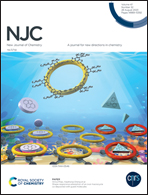Construction of a AgBr–Ag2MoO4 heterojunction and its photocatalytic sterilization activity†
Abstract
A AgBr–Ag2MoO4 heterojunction with high inactivation of E. coli under visible-light illumination was constructed. The crystal structure, morphology, elemental composition, and optical properties were characterized by TEM, SEM, XRD, XPS and DRS. The photocatalytic inactivation of E. coli by AgBr, Ag2MoO4, and AgBr–Ag2MoO4 was investigated. The results indicate that AgBr–Ag2MoO4 shows the best disinfection activity compared to AgBr and Ag2MoO4, with the E. coli being almost completely inactivated after illumination for 80 min. In addition, the cell structure of the bacteria is destroyed after visible-light irradiation in the presence of the catalyst. The UV absorption detection confirms that the bacterial protein leak and the concentration of nucleic acid in the solution also increase with the increase of the reaction time, indicating that the integrity of the bacterial cell membrane is damaged. The detection of ROS scavengers indicates that the reactive species (h+, ˙OH, e− and ˙O2−) play an important role in the inactivation of bacteria. The EPR tests confirm that the amount of ˙OH is higher than that of ˙O2− during the illumination process, which is consistent with the results of the free-radical capture tests. The heterojunction of AgBr–Ag2MoO4 is beneficial for the separation of photogenerated electrons and holes during the illumination process, resulting in an improvement of the antibacterial properties.



 Please wait while we load your content...
Please wait while we load your content...